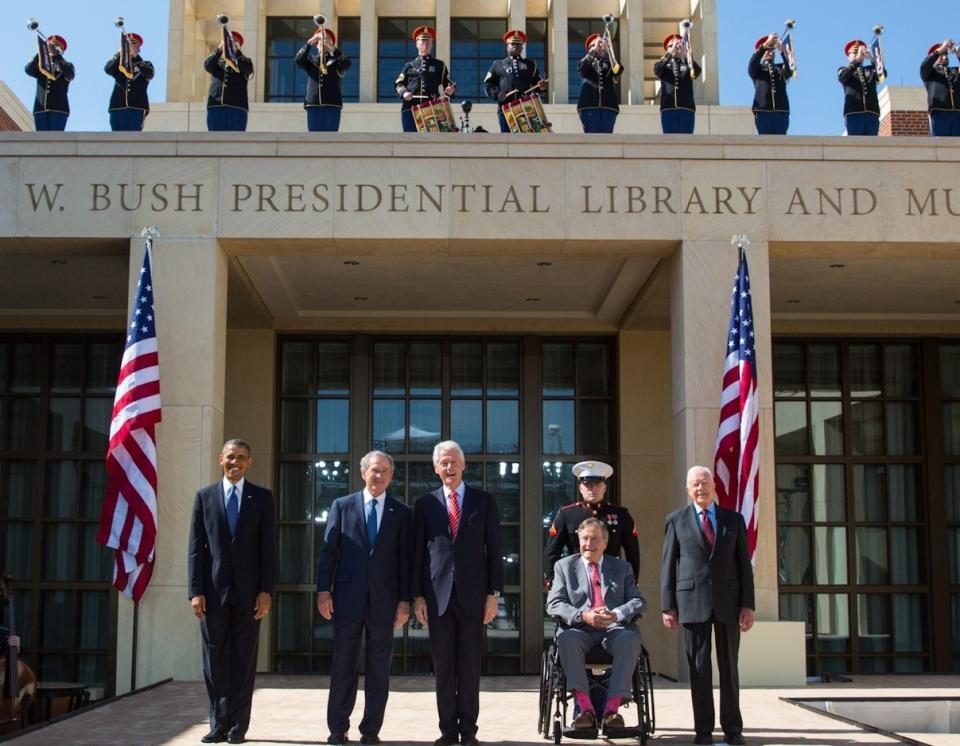On April 25, 2013, Presidents Jimmy Carter, George H. W. Bush, Bill Clinton, George W. Bush, and Barack Obama joined more than 10,000 other guests on the campus of Southern Methodist University (SMU) in Dallas, Texas, to dedicate the George W. Bush Presidential Library and Museum. The dedication ceremony was the culmination of a tremendous effort as well as the beginning of a significant mission for the nation's 13th Presidential Library.
Administered by the National Archives and Records Administration (NARA), a U.S. Federal agency, Presidential Libraries hold the papers and records created by, for, or about Presidents and their administrations. Without the preservation of and access to these materials, the history of our nation would be incomplete. They document the key decisions, policies, and activities of the institution of the Presidency – the highest level of government – and provide a vital record of how a President and his staff arrive at crucial decisions.

The George W. Bush Presidential Library serves as a resource for the study of the life and career of George W. Bush, while also promoting a better understanding of the Presidency, American history, and important issues of public policy.
Archival Collection
The primary mission of every Presidential Library is providing information. The Bush Library has an immense set of archival collections. To learn more about the Archives check out the Research section. A number of aspects distinguish the Bush Library from previous Presidential Libraries. First, is the size of its electronic records archive, the Library has approximately 80 terabytes of electronic information, including 200 million email messages. If these emails were to be printed, they would total more than 1 billion pages. Second, the textual collection consists of roughly 70 million pages of paper records. This collection includes not only Bush’s presidential records but also his gubernatorial records, which the Library holds in partnership with the Texas State Library and Archives Commission. Third, with about 30,000 audiovisual recordings, 227 cubic feet of photo negatives, and just over 3.8 million photographs, the audiovisual archive is immense. Having converted to digital photography in 2005, the George W. Bush Presidential Library has many more photographs than any of its predecessors.
This vast volume of materials provides a wonderful resource for research, but also poses a challenge for the National Archives. For example, due to the volume of electronic records, when researchers were first permitted to make Freedom of Information Act requests (FOIA) to view Bush presidential records in January 2014, more records were requested within the first week than have been processed at the Ronald Reagan Presidential Library in 25 years.
Artifacts Collection
Additionally, the Library maintains approximately 47,250 artifacts, primarily foreign and domestic gifts given to the President and Mrs. Bush as well as other items obtained at events and during trips throughout his Presidency. Most famously, perhaps, the Library has the bullhorn used by President Bush during his visit to the World Trade Center after the terrorist attacks of September 11, 2001. These artifacts document the American experience and are used extensively in the George W. Bush Presidential Museum's permanent and special exhibits. Finally, the Library has an active loan program which allows other institutions to exhibit artifacts from the collection.
Public & Education Programs
Another way the Bush Library provides information is through public and education programs. Through teacher workshops, the creation of classroom materials, and other innovative programs, the Library has become a resource for students, teachers, and other education professionals. All these activities are geared toward helping teachers do their incredibly important work by providing materials and ideas for educating their students while meeting the standards they must attain. These programs center naturally on the teaching of history and civics, but also more fundamentally, on the importance of primary sources in education and research. In addition, the Library has started efforts designed to combine the teaching of civics and history with the very important topics of science, technology, engineering, and mathematics.